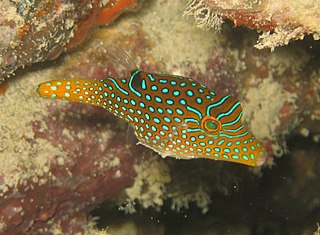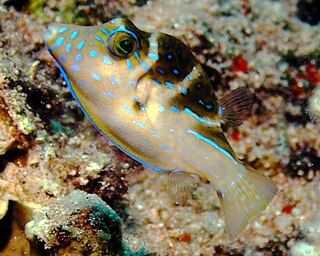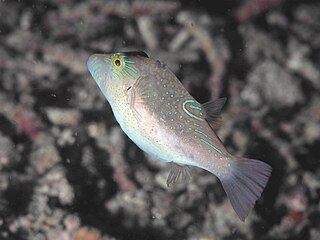
The clown toado a pufferfish of the genus Canthigaster, is found in the southwest Pacific Ocean including Australia, the northeast coast of New Zealand, and New Caledonia. Its length is between 10 and 20 cm.

Canthigaster is a genus in the pufferfish family (Tetraodontidae). A fish from this genus is sometimes referred to as a "toby" or a "sharpnose puffer".

Canthigaster papua, also known as the Papuan toby , is a demersal Marine fish belonging to the family Tetraodontidae.

Canthigaster coronata, commonly called the crowned toby, is a species of pufferfish endemic to the Hawaiian Islands. It occasionally makes its way into the aquarium trade.

Canthigaster rostrata, commonly known as the Caribbean sharp-nose puffer, is a pufferfish from the Western Central Atlantic. The Caribbean sharp-nose puffer is a small fish with a maximum length of 12 cm or approximately 4.7 inches. It can be encountered from the coast of South Carolina to Venezuela, including Bermuda, the Gulf of Mexico, and in the Caribbean Sea. They can live up to 10 years in the wild, females typically live longer due to aggressive male territory behavior. The Caribbean sharp-nose puffer is a highly toxic species of marine fish due to the presence of tetrodotoxin in its tissues and organs. Despite its toxicity, the sharp-nose pufferfish occasionally makes its way into the aquarium trade.

Canthigaster bennetti is a pufferfish from the Indo-Pacific. It occasionally makes its way into the aquarium trade. It grows to a size of 10 cm in length.

Canthigaster margaritata, the pearl toby, is a species of "toby" or "sharpnose puffer" (Canthigaster), which is part of the pufferfish family, Tetraodontidae. This reef fish is found in Indo-Pacific waters, including the Red Sea.

Canthigaster compressa, also known as the compressed toby or fingerprint toby, is a demersal Marine fish belonging to the family Tetraodontidae.
Canthigaster tyleri, also known as Tyler's toby, is a species of marine fish in the family Tetraodontidae.

Canthigaster amboinensis, commonly known as the Ambon pufferfish, the Ambon toby, or the spider-eye puffer, is a species of pufferfish of the family Tetraodontidae. The species is commonly seen in the tropical Indo-Pacific Ocean, including Australia, Indonesia, Japan, Papua New Guinea, Taiwan and the Hawaiian Islands. The species is named after the island of Ambon in Indonesia.

Canthigaster supramacula, known as the West African sharpnose-puffer, is a species of marine fish in the family Tetraodontidae. It was first isolated from the coast of central Africa, in the Atlantic Ocean. It is named in reference to the conspicuous ocellus-like spot on its side, anterior to its dorsal fin's base.

Canthigaster jamestyleri, known as the goldface toby, is a species of marine fish in the family Tetraodontidae. It was first isolated from the southeast coast of the US, in the Atlantic Ocean.

Canthigaster cyanospilota, commonly known as blue-spotted toby, is a species of pufferfish of the family Tetraodontidae. The species is found throughout the Indian Ocean, including the red Sea and Gulf of Aqaba. They feed on a variety of benthic invertebrates and are listed in the IUCN Red List as Least Concern.
Canthigaster criobe, known as the striped toby, is a species of pufferfish in the family Tetraodontidae. It is known only from French Polynesia, where it occurs at a depth range of 15 to 20 m. The species is currently known to reach up to 3.9 cm SL, though it is possible that larger specimens exist that have not yet been reported or collected as typical members of Canthigaster are notably larger. It has multiple thin brown stripes along its body, a feature which sets it apart from its congeners. It was described in 2012 and named for the Centre de Recherche Insulaire et Observatoire de l'Environnement (CRIOBE), Moorea, French Polynesia, in recognition of the laboratory's continued support of marine research in the area.

Canthigaster epilampra, known as the lantern toby, is a species of pufferfish in the family Tetraodontidae. It is an Indo-Pacific species that ranges from Christmas Island in the west to the Hawaiian and Society Islands in the east, the Ryukyu Islands in the north, and Tonga and Rarotonga in the south. It inhabits outer reef slopes at a depth of 6 to 60 m, and it is usually seen at depths greater than 24 m (79 ft). It reaches 12 cm in total length, and it feeds on mollusks, echinoderms, brachiopods, and algae. The species is usually encountered alone or in pairs.

Canthigaster janthinoptera, known as the honeycomb toby, is a species of pufferfish in the family Tetraodontidae. It is native to the Indo-Pacific, where it can be found along the east coast of Africa south to South Africa's Eastern Cape province, east to Oeno Island and the Line and Marquesas Islands, north to Japan, and south to Lord Howe Island. It is replaced by its relative C. jactator near the Hawaiian Islands and by C. punctatissima in the Eastern Pacific. It occurs in reef environments, often near sponges, at a depth range of 1 to 30 m, and it reaches 9 cm in total length. The species is reported to feed on sponges, polychaetes, and algae, in addition to small quantities of tunicates, crustaceans, echinoderms and corals. It is an oviparous species usually encountered alone or in pairs.

Canthigaster natalensis, known as the Natal toby, is a species of pufferfish in the family Tetraodontidae. It is native to the southwestern Indian Ocean, where it ranges from Mozambique and South Africa to Réunion and Mauritius. It is an oviparous species that reaches 8.6 cm SL.
Canthigaster ocellicincta, commonly known as the shy toby, is a species of pufferfish in the family Tetraodontidae. It is native to the Western Pacific where it ranges from Indonesia and the Philippines to Fiji, the Ryukyu Islands, the Great Barrier Reef, and New Caledonia, although it has recently been recorded from Tonga. It occurs at a depth range of 10 to 53 m and reaches 7.5 cm SL. The species is usually seen in invertebrate-rich reef caves at more than 25 m (82 ft) depth. While generally found alone or in pairs, although small groups have been reported on at least one occasion. It is noted to be a very secretive species that feeds on algae and small invertebrates.

Canthigaster pygmaea, commonly known as the pygmy toby, is a species of pufferfish in the family Tetraodontidae. It is known only from the Red Sea, where it occurs at a depth range of 2 to 30 m. It inhabits coral reefs and is very secretive, often being found hidden in small holes. It is a small oviparous fish, reaching 5.6 cm in total length.

Canthigaster smithae, known as the bicolored toby, is a species of pufferfish in the family Tetraodontidae native to the Indian Ocean. It ranges from Agaléga, Mauritius to Durban, South Africa, as well as the Maldives. It is a reef-associated species found at a depth of 20 to 40 m, where it typically occurs alone near rubble and steep rock walls. It is oviparous and reaches 13 cm in total length.

















